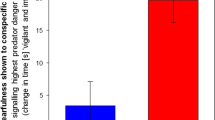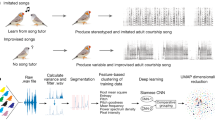Abstract
INVESTIGATION of wild rabbits confined in experimental enclosures of approximately 2 acres at Gungahlin, near Canberra, and at Albury has established the existence of discrete social groups, each with its own territory and dominance hierarchy4,5. In the enclosure at Gungahlin, rabbits have been observed to mark objects in their territories with the secretion of the chin gland, as well as with urine and fæces. Features such as the edges of posts, tips of grass blades and branches, edges of burrow entrances, walls and ceilings of cages, and even kittens and does during amatory behaviour, are subjected to ‘chinning’ during which they are smeared with small amounts of secretion.
Similar content being viewed by others
Article PDF
References
Buschke, W., Z. Zellforsch. und mikroskcop. Anat., 18, 217 (1933).
Krause, W., Die Anatomie des Kaninchens in topographischer und operativer Rücksicht, second ed. (Engelmann, Leipzig, 1884).
Schaffer, J., Die Hautdrüsenorgane der Saügetiere (Urban and Schwarzenberg, Berlin and Wien, 1940).
Myers, K., and Mykytowycz, R., Nature, 181, 1515 (1958).
Mykytowycz, R., C.S.I.R.O. Wildl. Res., 3, 7 (1958).
Author information
Authors and Affiliations
Rights and permissions
About this article
Cite this article
MYKYTOWYCZ, R. Territorial Function of Chin Gland Secretion in the Rabbit, Oryctolagus cuniculus (L.). Nature 193, 799 (1962). https://doi.org/10.1038/193799a0
Issue Date:
DOI: https://doi.org/10.1038/193799a0
Comments
By submitting a comment you agree to abide by our Terms and Community Guidelines. If you find something abusive or that does not comply with our terms or guidelines please flag it as inappropriate.



